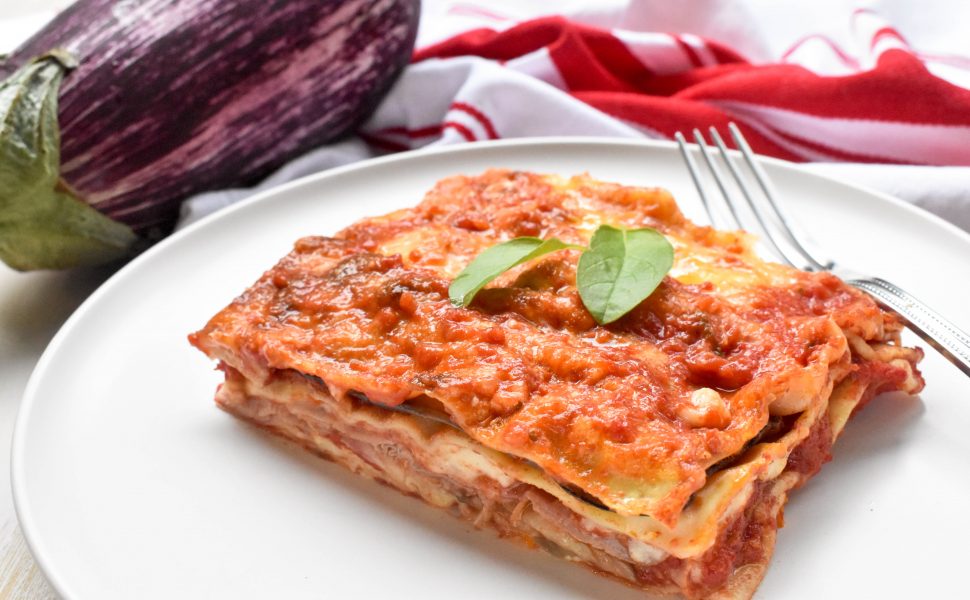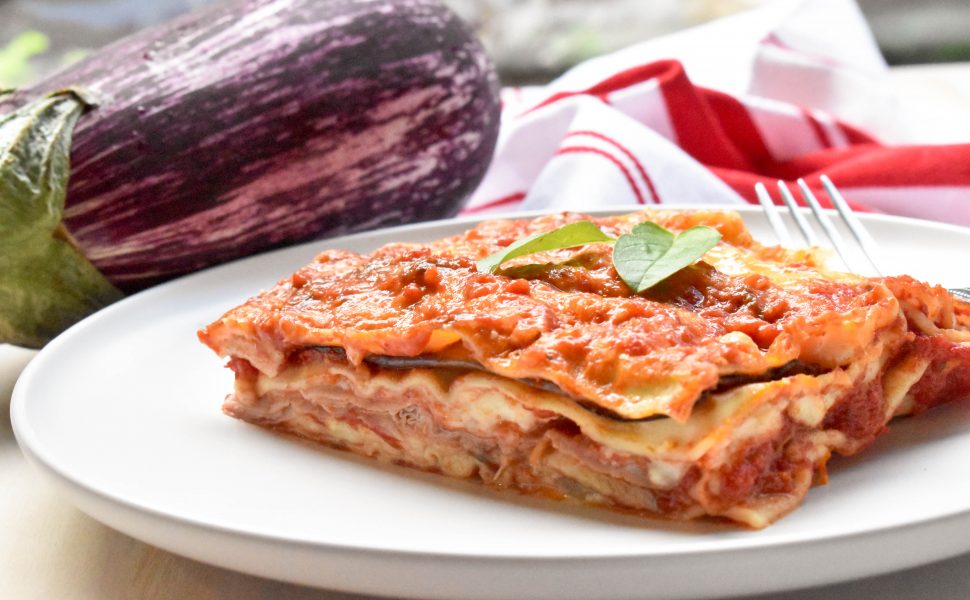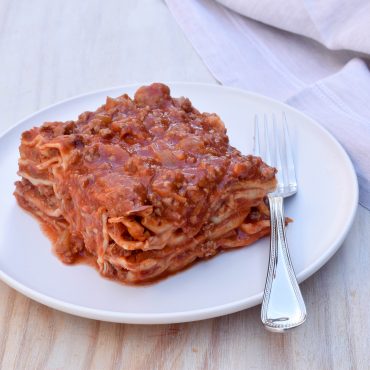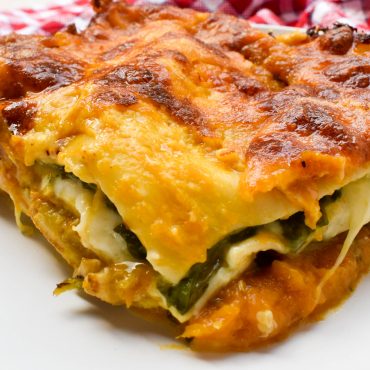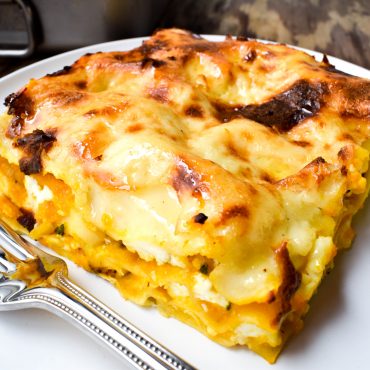Lasagne ‘alle melanzane’ (of eggplant/aubergine)
- 400g fresh lasagne sheets (alternatively use dried sheets that require no pre-cooking) – to make your own pasta, refer to note in step 6
- 1.2kg eggplant (aubergine) – see note in step 3
- 300g mozzarella cheese, cut into small cubes
- 60g Parmigiano Reggiano cheese, finely grated (alternatively use Grana Padano)
- 150g ham, thinly sliced
- 20 basil leaves, roughly chopped
- Canola oil for frying eggplant
- Sea salt
- 3 tablespoons (60ml) extra virgin olive oil
- 1 large onion, finely chopped
- 1 clove garlic, whole
- 2kg ripe Roma tomatoes, roughly chopped (alternatively 4X 400g cans of good quality tomatoes) – see note in step 1
- 10 large basil leaves
- 2 teaspoons sugar
- Sea salt
- 60g unsalted butter
- 60g 00 flour [alternatively, plain (all-purpose) flour]
- 600ml full-cream milk (cold)
- 1 bay leaf
- Freshly grated nutmeg
- Sea salt
Requires: Food mill
To make the Tomato and basil sauce, place the olive oil in a heavy-based stockpot over medium heat. Add the onion and garlic. Cook until the onion is soft. Add the Roma tomatoes (or canned tomatoes). Bring to the boil, then add the basil, sugar and a pinch of salt. Reduce the heat to low and simmer for approximately 1 hour or until the sauce has reduced to your required consistency, stirring occasionally so that the sauce does not stick to the pot and burn, then remove from the heat. Discard garlic clove. Set aside to cool.
Note: Roma tomatoes need to be ripe and flavorsome for this recipe. Use quality fresh Roma tomatoes only in the summer months of the year. Alternatively, use good quality canned tomatoes such as San Marzano.
Preheat the oven to 200°C conventional oven/ 180°C fan-forced (400° Fahrenheit/Gas 6). Grease a baking dish (approximately 24 X 34cm in size) with butter or margarine.
Meanwhile, use a sharp knife to slice the eggplant (aubergine) 5-10mm thick, leaving the skin on – see note in this step. Heat the oil in a large frying pan over medium heat. Fry the eggplant slices, in batches until golden brown (approximately 2 to 3 minutes on each side). Season the eggplant with salt as you cook them and transfer to a plate lined with paper towel. Add more oil and repeat with the remaining eggplant.
If you are using a black-skinned eggplant, however, you will need to salt the eggplant. To do this, slice the eggplant as per step 3, sprinkle both sides of the eggplant slices with salt and layer in a colander. Set aside for 20 minutes. Rinse under cold water, drain and use paper towel to pat dry.
Note: In Italy, there are excellent varieties of ‘melanzane’ (eggplant/aubergine) that are rounded and a vibrant purple colour such as ‘Rosa Bianca’, ‘Violetta di Firenze’, ‘Bianca Sfumata di Rosa’, and ‘Prosperosa’. These varieties have a more delicate flavour and are not bitter. In Australia, I choose Graffiti eggplant (also known as Sicilian eggplant) – they are less seedy and also not bitter. The Italian varieties and Graffiti eggplant do not need to be salted and rinsed before cooking.
To make the Besciamella sauce, melt the butter in a medium-sized saucepan over medium heat until foaming. Add the flour and stir with a wooden spoon to form a smooth paste (a roux). Allow the flour and butter mixture to cook for a minute (but do not allow it to brown). Remove from the heat. Slowly pour the cold milk into the roux, stirring constantly, until the mixture is smooth. Add the bay leaf and return to medium heat. Cook, stirring with the wooden spoon until the Besciamella comes to the boil and thickens (approximately 10 minutes). Remove from heat. Season with salt to taste and stir in freshly grated nutmeg. Set aside to cool slightly.
Prepare your food mill over a clean saucepan or stockpot. Ladle the cooked tomato and basil sauce into the food mill and stir to collect the lovely tomato pulp and juice in the pot. Discard the tomato skins and seeds that are left in the food mill. The Tomato and basil sauce is now ready and you can start to assemble the lasagne.
Remove the fresh lasagne sheets from the packet.
Note: If you are making your own pasta for this recipe, use 1 quantity of Fresh egg pasta and divide the dough into 2 or 3 pieces. Use a pasta machine to roll out the dough, starting with the highest setting. Fold the pasta sheet in half, then roll out through the pasta machine several times to laminate the pasta. Adjust the setting on the pasta machine and fold the pasta sheet in half each time you feed the pasta dough into the machine until the dough is very thin (approximately 1-2mm).
Ladle a thin layer of Tomato and basil sauce to just cover the base of the baking dish. Cover with a layer of pasta sheets that overlap slightly. Spoon Tomato and basil sauce where the pasta overlaps. Ladle 1/3 of the remaining Tomato and basil sauce over the pasta sheets and use the back of a spoon to level it. Spread 1/4 of the besciamella sauce over the Tomato and basil sauce. Make a slightly overlapping layer using 1/2 of the eggplant slices over the tomato sauce. Scatter half of the chopped basil leaves. Cover with a layer of pasta sheets, overlapping slightly. Once again spoon Tomato and basil sauce where the pasta overlaps. Ladle 1/2 of the remaining Tomato and basil sauce over the pasta sheets and use the back of a spoon to level it. Spread 1/3 of the remaining besciamella sauce over the Tomato and basil sauce. Sprinkle 1/2 of the mozzarella cheese over the sauce and about 1/4 of the Parmigiano (or Grana Padano). Arrange all (150g) of the ham, slightly overlapping, over the cheese layer. Continue layering using the remaining eggplant then sprinkle over all basil leaves, followed by remaining Tomato and basil sauce, then layer using 1/2 of the remaining besciamella sauce. Finish with a layer of pasta, remaining besciamella sauce, mozzarella cheese and Parmigiano Reggiano sprinkled to cover the lasagne.
Bake in a preheated oven for 20-25 minutes. Remove from the oven. To confirm that the lasagne is cooked, insert a knife in the center of the baking dish and hold it there for a few seconds – if the knife blade is hot, the lasagne is ready. Leave to rest for a minimum of 10 minutes before serving.
Cut the Lasagne ‘alle melanzane’ (of eggplant/aubergine) into 6 portions and serve – buon appetito.

